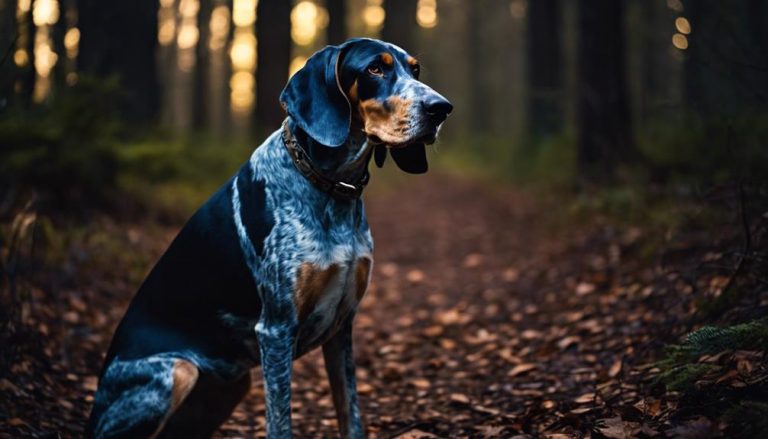Bluetick Coonhound: Characteristics and Care
The Bluetick Coonhound hails from Louisiana, USA, and stands out due to its unique blue-ticked coat and strong hunting skills. The American Kennel Club acknowledged it in 1946. These dogs are on the larger side and require plenty of exercise and a diet that meets their specific needs to stay healthy. They are prone to certain health issues like hip dysplasia, bloat, and ear infections.
They need good exercise and a diet rich in proteins and omega-3 fatty acids to keep them at their best. They typically live for about 11-12 years.
Caring for a Bluetick Coonhound means paying attention to their diet and ensuring they get enough physical activity. Regular vet check-ups are essential. Their coat needs brushing every week, and their ears need cleaning occasionally to avoid infections. Understanding and meeting their needs is critical to their well-being.
Key Takeaways
- Bluetick Coonhounds excel in hunting with their distinct coat.
- It originated in Louisiana, recognized since 1946.
- It would help if you exercised daily and were aware of hip dysplasia and ear issues.
Quick Facts
Originating from Louisiana in the United States, Bluetick Coonhounds are medium-sized dogs celebrated for their unique blue-ticked coat and exceptional hunting abilities. These dogs are part of the Hound group, known for their skills in tracking and hunting. They typically live for 11 to 12 years, showing a solid genetic resilience that suits their active roles.
Their short and smooth coats offer protection against the rough outdoors. The blue-ticked pattern is visually striking and helps them blend into various environments during hunts. This coat type is low maintenance perfect for a working dog.
Bluetick Coonhounds are full of energy, a trait essential for dogs involved in intense, long-distance tracking. They use this energy efficiently in hunting, showcasing their stamina and determination. Their physical characteristics, including their manageable coats, equip them for challenging tasks requiring speed, endurance, and sharp senses.
Overview
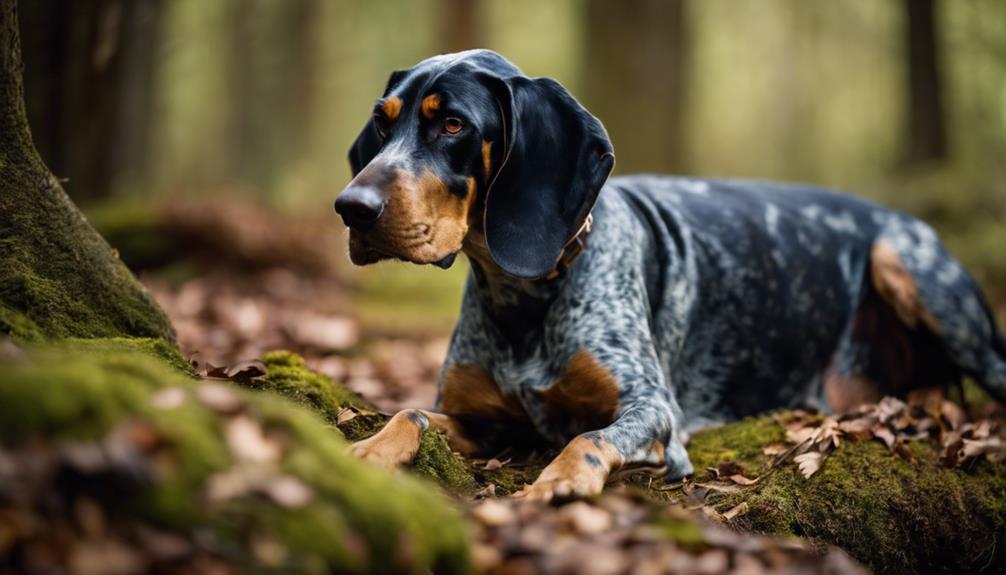
The Bluetick Coonhound is a dog breed known for its striking blue-ticked coat and excellent hunting skills. These dogs come from the southern United States, with Louisiana often cited as their origin. They gained recognition for their ability to track and hunt game. The American Kennel Club made it official by listing them as a distinct breed in 1946.
These medium-sized dogs stand out with their blue ticked coat pattern, adorned with black and white patches. This not only makes them visually appealing but also underscores their hardworking nature. Bluetick Coonhounds are healthy dogs, generally living for about 11-12 years.
They are incredibly active and require a lifestyle that keeps them engaged. This breed does best with a ‘full-time job’ or regular, energetic activities. Their need for physical and mental exercise makes them perfect companions for active individuals or families ready to meet these needs.
Distinctive Melodic Howl
One of the standout features of the Bluetick Coonhound is its melodic howl. This howl isn’t just for show – it plays a crucial role in how these dogs communicate. Their deep, musical barks are a way to tell others where they are, signal to their human friends or other dogs about different situations, and share their feelings. This howling is closely linked with their instinct to hunt. It gets louder and more frequent when they follow a scent or have found prey. The sound of their howling and vocal abilities make them very appealing pets for those who love these traits.
| Aspect | Detail |
|---|---|
| Function | Used for communication, signaling location, and sharing emotions |
| Relation to Hunting | Intensifies with the detection of a scent or when prey is nearby |
| Contribution to Charm | Enhances their appeal through unique vocal talents |
Studying the Bluetick Coonhound’s howl gives us insight into its role in the dog’s behavior and how it communicates. This showcases how their instincts, feelings, and social interactions are all connected through their distinctive howling.
Origin in Southern USA
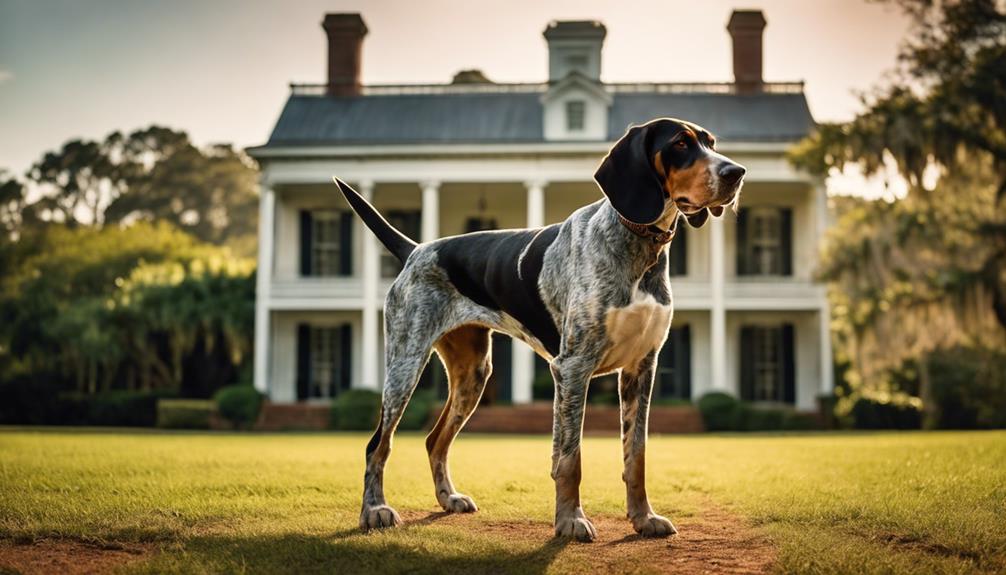
The Bluetick Coonhound has a rich history that traces back to the Southern United States, with Louisiana playing a crucial role in its development. This dog breed stands out because of its unique beginnings, including blending the Grand Bleu de Gascogne with local hounds.
In 1946, the Bluetick Coonhound was officially recognized as its breed. This was a significant milestone for the breed and highlighted its unique characteristics and abilities. Later 2009, it entered the American Kennel Club, marking its acceptance and popularity within the dog community.
Another gripping action is the rise of the American Blue Gascon Hound, a variant within the Bluetick breed. This highlights the breed’s versatility and adaptability. These points illustrate the Bluetick Coonhound’s historical importance and cultural significance in the South. It shows how this breed has become an enduring part of American canine heritage.
Southern Roots Explored
In the southern United States, especially in Louisiana, the Bluetick Coonhound has its roots deeply intertwined with the area’s strong hunting culture. This dog descended from the Grand Bleu de Gascogne, is a testament to how local traditions can shape the development of dog breeds.
The Bluetick Coonhound was officially recognized as its breed in 1946 and later by the American Kennel Club in 2009. This journey underscores its importance in the Southern lifestyle, especially in hunting. The creation of the American Blue Gascon Hound subgroup further shows how the breed has adapted over time.
These steps in the breed’s history are milestones and highlight the Bluetick Coonhound’s lasting connection to hunting traditions in the South. They tell us about the breed’s ongoing relevance and how it continues to be a part of the region’s cultural fabric.
Historical Significance
Originating in the fertile lands of the Southern USA, particularly Louisiana, the Bluetick Coonhound is deeply rooted in the region’s rich hunting culture. This breed, which came from the Grand Bleu de Gascogne hound, reflects the South’s long history of depending on hunting for both food and sport. The Bluetick Coonhound was officially recognized as a breed in 1946 and was welcomed by the American Kennel Club in 2009, marking it as a critical part of Southern hunting traditions.
Within this breed, there’s a specific group known as the American Blue Gascon Hound, highlighting the Bluetick Coonhound’s varied genetic background and its essential place in the cultural history of the South. This distinction showcases the breed’s unique characteristics and its role in continuing the legacy of hunting practices in the Southern United States.
Cultural Impact
The Bluetick Coonhound is deeply rooted in the hunting traditions of the Southern USA, especially in Louisiana. This breed, whose origins trace back to the Grand Bleu de Gascogne in France, became its own recognized breed in 1946. It wasn’t until 2009 that the American Kennel Club officially acknowledged it. This recognition speaks volumes about the breed’s importance for hunting and as a vital part of the South’s cultural heritage.
The Bluetick Coonhound’s impact goes beyond being a hunting companion. It stands as a testament to the area’s history and values. In Louisiana, the presence of this breed highlights its significance in weaving the cultural tapestry of the Southern USA. Its journey from French origins to American recognition showcases how deeply entwined it is with the region’s identity.
Large Breed Size
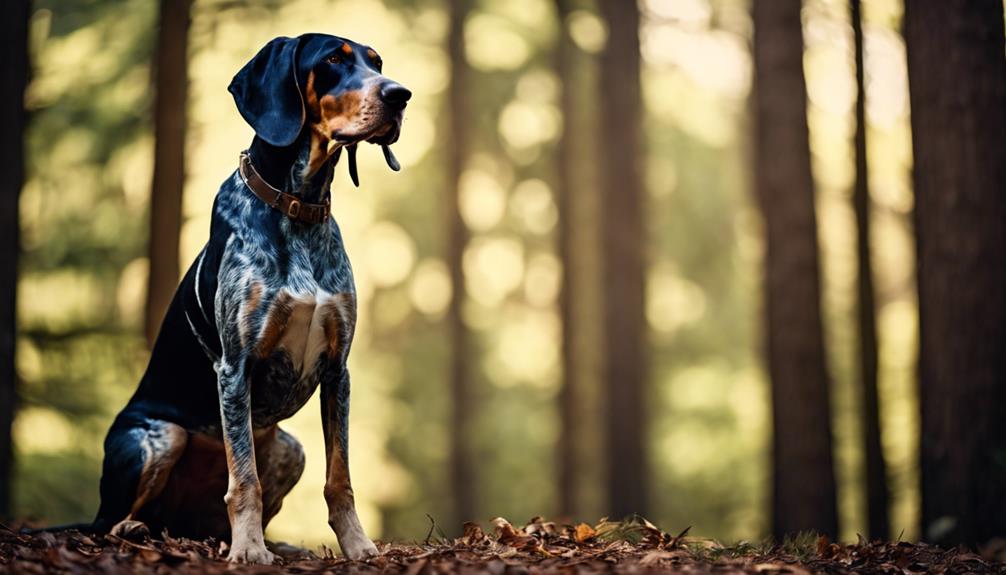
Caring for a Bluetick Coonhound, a breed known for its size, requires careful attention to several key areas to ensure they lead a healthy and happy life. These include:
Keeping them within a healthy weight range of 45-80 pounds is essential. This depends on whether you have a male or female. It’s crucial for their muscular build and to prevent joint strain.
They also need enough space. Given their size and energy, Bluetick Coonhounds must have plenty of room to move around and stay active. This is not just for their physical health but for their happiness, too.
When it comes to exercise, these dogs have high stamina and love to stay active. Regular walks, playtime, and other activities that keep them moving are vital for their physical and mental well-being.
Nutrition is another critical aspect. Their diet should match their size, metabolism, and how active they are. Proper nutrition supports their overall health and keeps them in top condition.
Ideal Weight Range
For male Bluetick Coonhounds, the ideal weight is between 55-80 pounds. Female Bluetick Coonhounds should generally weigh between 45-65 pounds. Keeping these dogs at a healthy weight is crucial for their overall health and lifespan. It’s essential to feed them a balanced diet and ensure they get enough exercise to avoid issues related to being overweight, which can affect their quality of life and longevity.
Regular check-ups and discussions with a vet can help tailor the Bluetick Coonhound’s diet to meet their specific needs, considering their activity. A combination of the right food and plenty of exercise that taps into their natural energy and endurance is vital to maintaining their weight within the recommended range. This approach supports their health and happiness.
Space Requirements
Bluetick Coonhounds are a medium to large-sized breed with plenty of room to move and play because of their high energy and athletic nature. Males usually weigh between 55-80 pounds and females 45-65 pounds, so these dogs are built strong and have a lot of energy to burn.
A big yard or easy access to outdoor spaces is perfect for these dogs. They love to explore, run, and play, which helps them stay healthy and happy. A spacious living area helps prevent behavior problems if cooped up and bored. Bluetick Coonhounds’ well-being needs enough space to live a fulfilled life.
Exercise Needs
Bluetick Coonhounds are large dogs that need plenty of daily exercise to stay healthy and happy. They should get around 90 minutes of activity to keep them in good shape and prevent boredom. This breed loves to stay active through walking, running, hiking, and playing games. These activities help them burn off energy and keep their minds sharp.
Their physical and mental health must meet their exercise needs. Without enough activity, Bluetick Coonhounds might start showing unwanted behaviors. Regular exercise helps them maintain calm and improve their overall quality of life. So, owners must ensure they’re up for keeping these energetic dogs active and engaged.
Nutrition Guidelines
Caring for Bluetick Coonhounds means paying close attention to their diet. Large, energetic dogs need a balanced meal plan that fuels their activity. Protein is vital for their muscle health and overall well-being, with chicken or lamb being excellent choices. It’s also beneficial to include omega-3 fatty acids, found in fish oil, to keep their coats shiny and support brain health.
Managing how much and when they eat is crucial to avoid weight gain, which is common in large breeds. Getting advice from a vet can help customize the diet to your dog’s specific needs, considering their age and how active they are. This personalized approach ensures they get what they need for a happy, healthy life.
Health Considerations
Given their size, Bluetick Coonhounds face a higher chance of encountering health issues like hip dysplasia and bloat, which calls for attentive care. These dogs, weighing 45 and 80 pounds based on sex, need close monitoring for joint problems, particularly hip dysplasia. This condition hampers the normal development of the hip joint.
The threat of bloat, a dangerous stomach issue, should be addressed without delay. Proper feeding and consistent exercise are crucial in lowering these health risks. Regular visits to the vet are vital for catching and handling any health concerns early, helping to improve the quality of life and longevity of these dogs.
Loyal Nature

The Bluetick Coonhound‘s loyalty is a standout quality that makes them excellent family dogs. Their loyalty shows in several ways, making them a top choice for those looking for a dedicated pet.
They are incredibly loyal to their families and always ready to show affection and dedication. These dogs create solid and lasting connections with their owners, making them more than just pets; they become part of the family.
Their willingness to learn and follow commands not only shows their intelligence but also enhances their instinct to protect. This makes them great companions who are both enriching and comforting to have around.
Understanding and nurturing these traits is critical to a happy life with a Bluetick Coonhound. Their devotion and protective nature make them not just pets but loyal friends.
Demonstrating Loyalty
Bluetick Coonhounds are incredibly loyal dogs, forming deep bonds with their families. They are always ready to offer comfort and understand when their owners feel down, reacting with genuine empathy. This breed’s loyalty isn’t just about being affectionate; it’s about being in tune with how their people think, offering support when needed most.
Their behavior is rooted in a strong desire to be part of a team, whether at home or while hunting. This teamwork is crucial in hunting, where their ability to work together shines.
Their unwavering dedication to their family’s safety and happiness highlights their strong connection with their humans. Bluetick Coonhounds are always there, watching for any trouble and proving their loyalty through their actions. Their instinct to protect and be a constant companion makes them valued family members.
Bonding With Families
Bluetick Coonhounds have a knack for creating deep emotional bonds with their human families, making them standout companions. Their loyalty isn’t just a trait; it’s part of their essence. These dogs show love through constant affection, contributing to a family’s well-being and security. They are always eager to engage with their owners, enhancing those connections.
Their protective nature also means they are always alert to protect their loved ones. This blend of traits makes Bluetick Coonhounds more than pets; they become cherished family members.
Responding to Training
The Bluetick Coonhound’s loyalty is a critical factor in their trainability. This loyalty helps create a strong bond between the dog and its owner, making training more effective.
Positive reinforcement aligns well with their eagerness to please, allowing trainers to guide the breed’s energy and hunting instincts in a positive direction. These dogs enjoy learning new things and making training sessions fun and productive.
Their desire to work closely with their human partners highlights the need for consistent, encouraging training methods to tap into the breed’s full potential.
Protective Instincts
A standout trait of the Bluetick Coonhound is their protective solid instinct, deeply tied to their loyalty towards their family and home. This breed is naturally inclined to keep their surroundings safe, serving as alert watchdogs. They bark at unfamiliar sounds or potential threats, showing their commitment to protection.
Their bravery shines when they sense danger, ready to protect their loved ones without a second thought. Their protective nature and steadfast loyalty make the Bluetick Coonhound a perfect choice for anyone looking for a faithful and vigilant companion. These qualities ensure they are treasured home protectors, embodying the spirit of loyalty and a protective mindset.
Companionship Qualities
Bluetick Coonhounds are known for their deep emotional connections with their families, showing true companionship through their loyal nature. They’re affectionate with family members and protective, always on guard to keep their home and loved ones safe. Their eagerness to spend time with their human friends strengthens their bond, making them dependable companions.
These dogs also carry their loyalty into the outdoors, especially when hunting. They’re committed to tracking and capturing prey with a focus that highlights their dedication to the task. This loyalty showcases the Bluetick Coonhound’s well-rounded companionship, marking them ideal pets and protectors.
Common Health Concerns

Taking care of Bluetick Coonhounds involves a comprehensive strategy to ensure their health and happiness. This includes recognizing and managing genetic disorders early on. It’s crucial to catch these issues quickly to provide the best care.
Preventing joint problems is another crucial aspect. Regular exercise and a proper diet can help keep your dog’s joints healthy, reducing the risk of issues as they age. A balanced diet is vital for joint health and crucial in preventing obesity. Overweight dogs face many health risks, so keeping an eye on their food intake and getting enough exercise is essential.
Ear infections and eye conditions are expected in Bluetick Coonhounds, so regular check-ups are essential. Keeping their ears clean and monitoring their eyes can help catch and treat any issues early, preventing long-term damage.
These strategies can significantly improve your Bluetick Coonhound’s quality of life. Regular vet visits and a keen eye on their health can make a big difference in catching and managing potential health concerns.
Identifying Genetic Disorders
Bluetick Coonhounds face a few health challenges that can significantly affect their well-being, like hip dysplasia, ear issues, bloat, and elbow dysplasia. It is crucial to stay on top of their health care to catch and address these problems early.
Hip dysplasia involves a poorly formed hip joint that can limit a dog’s movement and cause discomfort. Their floppy ears also make them prone to ear infections since they trap moisture and dirt, creating a perfect breeding ground for bacteria and fungi.
Bloat is an emergency where the stomach twists, and immediate vet attention is needed. Elbow dysplasia, similar to hip dysplasia, hampers proper joint formation, leading to pain and difficulty moving. Keeping up with regular vet visits helps spot and treat these issues promptly.
Preventing Joint Issues
To keep Bluetick Coonhounds healthy and prevent joint problems like hip dysplasia, elbow dysplasia, and arthritis, it’s vital to keep them at a healthy weight. This involves feeding them a balanced diet and ensuring plenty of exercise. Including joint-supporting supplements such as glucosamine and chondroitin in their diet can also help maintain strong joints and reduce the risk of such issues.
Regular visits to the vet can catch any early signs of joint problems, making treatment more straightforward. It’s also beneficial to design exercise routines that strengthen the muscles around the joints. This support can lessen the chances of joint issues becoming a significant problem. This approach emphasizes the importance of a well-rounded lifestyle in keeping your Bluetick Coonhound’s joints healthy.
Managing Obesity Risks
For Bluetick Coonhounds, keeping a healthy weight is crucial. This breed is prone to obesity, which can lead to serious health issues, including problems with their joints and heart disease. To avoid these risks, it’s essential to carefully manage their diet and ensure they get plenty of exercise.
Controlling what they eat and how much is vital to preventing weight gain. This means feeding them the right amount of food and avoiding overfeeding. Regular check-ups with a vet are also important. These visits can help track the dog’s weight and catch any early signs of obesity.
Encouraging Bluetick Coonhounds to stay active through play and other activities is another effective way to keep them fit and healthy. An active lifestyle not only helps prevent obesity but also keeps them happy and engaged.
Grooming Essentials
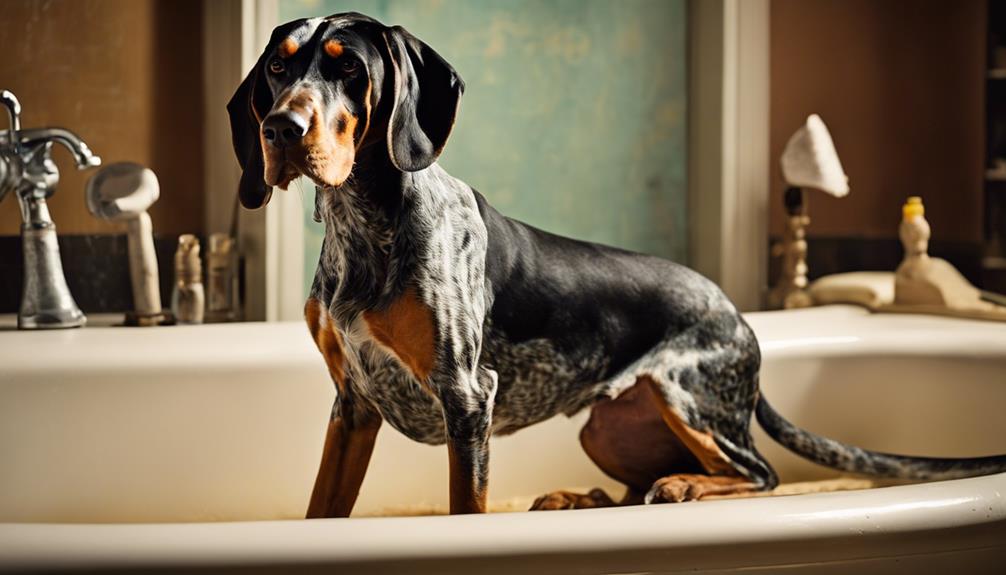
When caring for Bluetick Coonhounds, it’s crucial to have a good grooming routine. This keeps them looking sharp and supports their health and wellness. We’ll cover four key areas: coat care, nail trimming, ear cleaning, and the proper brushing methods. These steps are essential for keeping your dog in top condition.
Primary coat care is the foundation of grooming. Regular brushing removes dirt and loose fur, which helps prevent mats and keeps their coat shiny. For nail trimming, it’s about more than looks. Keeping nails at the right length protects your dog from pain and mobility issues. An ear cleaning routine is vital, too, as it prevents infections that can lead to serious health problems.
Brushing techniques vary, but finding the right one for your Bluetick Coonhound can make all the difference. It distributes natural oils throughout their coat and can be a great bonding experience. Together, these practices form a comprehensive grooming plan that ensures your dog looks great and stays healthy and happy.
Basic Coat Care
Maintaining a Bluetick Coonhound’s coat in tip-top shape requires a straightforward grooming regime that includes brushing once a week, bathing regularly, and careful attention to its ears and nails. Their short, smooth coat, which is slightly coarse, looks its best and stays healthy with weekly brushing. This routine keeps their coat shiny and minimizes shedding by removing loose fur and promoting skin health. Bathing your dog once a month keeps them smelling fresh and contributes to their overall coat maintenance.
To avoid ear infections, a common issue in dogs with long, floppy ears, cleaning their ears regularly is vital. A comprehensive grooming routine ensures your Bluetick Coonhound stays in optimal condition, looking good and feeling even better.
Nail Trimming Tips
Maintaining your Bluetick Coonhound’s health and comfort includes trimming its nails. Overgrown nails can cause discomfort, affect the dog’s posture, and lead to joint problems. Nail trimming is vital for your dog’s grooming and well-being. Using the right tools, like guillotine or scissor-type clippers, is essential to trim the nails safely. It would be best if you were careful to avoid the quick blood vessels inside the nail to prevent hurting your dog.
If you’re not confident in trimming your dog’s nails, it’s a good idea to ask for help from a professional groomer or vet. This ensures the safety and proper care of your Bluetick Coonhound’s nails.
Ear Cleaning Routine
After discussing nail trimming, it’s equally critical to discuss ear cleaning for Bluetick Coonhounds. A regular cleaning schedule helps prevent ear infections and keeps their ears in good shape. Using a vet-recommended solution for cleaning their ears is critical. Make sure to clean the outer part of their ear canal gently and avoid pushing anything deep inside to prevent harm. Watching for signs like redness, swelling, bad smell, or unusual discharge is essential for catching any problems early. A consistent ear-cleaning routine ensures your Bluetick Coonhound stays happy and healthy.
It’s all about keeping their ears clean and dry, which lowers the chance of infection. Being proactive in ear care will significantly improve your dog’s quality of life.
Brushing Techniques
When grooming Bluetick Coonhounds, a slicker brush is crucial for removing loose fur and preventing mats. This method begins at the head and moves down the body to ensure the whole coat is cared for. The slicker brush’s fine wire bristles are ideal for gently detangling and removing dead hair, making grooming a comfortable experience for your dog.
Paying close attention to the ears is vital, as this breed is more susceptible to infections in that area. Regular ear cleaning and weekly brushing are crucial to keeping your Bluetick Coonhound healthy and looking their best. This routine keeps their coat shiny and helps prevent skin and ear issues.
Bathing Frequency
When caring for Bluetick Coonhounds, how often to bathe them is critical to keeping their coat healthy and clean. Generally, these dogs need a bath every 2-3 months.
But the right frequency depends on how active your dog is, how much dirt they get into, and if they have any skin issues. Washing them too much can strip their coat of essential oils, leading to dryness and skin problems.
Dietary Needs
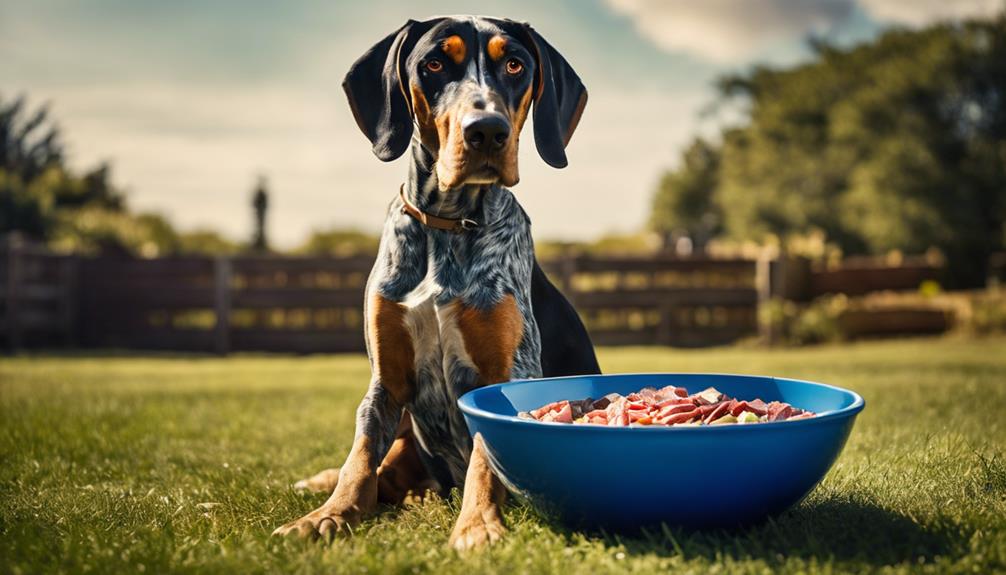
When it comes to feeding Bluetick Coonhounds, getting their diet right is critical to keeping them healthy and full of energy. A balanced diet for these dogs should include the right mix of proteins, fats, carbohydrates, vitamins, and minerals.
It’s also important to know which foods might cause allergic reactions in these dogs to avoid health issues. Setting a feeding schedule helps keep their energy steady throughout the day and aids in weight management.
Lastly, regularly checking in with a vet ensures your Bluetick Coonhound’s diet meets their needs, supporting a happy and healthy life.
Optimal Nutrient Balance
To ensure Bluetick Coonhounds thrive, their diet must include high-quality proteins, omega-3 fatty acids, and plenty of water. These elements are crucial for their energy levels and for maintaining a shiny coat.
Proteins are essential for building and repairing muscles. Omega-3s keep their skin healthy and their coats shiny.
Giving them constant access to clean water is also crucial to avoiding dehydration. Watching their food intake is necessary to prevent obesity. Consulting a vet can help customize their diet to meet their specific needs. This approach supports their overall health and keeps them active.
Common Food Allergies
Understanding the dietary sensitivities of Bluetick Coonhounds is crucial for their health and happiness. Ingredients like corn, wheat, soy, and artificial additives can cause allergic reactions in these dogs. They may also react badly to specific proteins like chicken, beef, or lamb. These allergies can lead to skin problems, digestive issues, or itching, making life uncomfortable for them.
Talking to a vet is an excellent step to figuring out what your Bluetick Coonhound can and cannot eat. Keeping track of what they eat and trying an elimination diet are good ways to find out what might be causing an allergic reaction. This helps ensure they get the proper nutrition while avoiding any allergens that could make them sick.
Recommended Feeding Schedule
Maintaining the health and vitality of Bluetick Coonhounds requires a specific feeding plan that suits their nutritional needs. It’s best to give them two well-balanced meals every day. This breed is naturally energetic, so a consistent meal schedule helps keep their energy optimal.
For puppies, it’s critical to feed them more often to support their growth. Watching their weight and adjusting food portions helps prevent obesity, especially in dogs that aren’t very active. A vet can offer advice on the right food amounts based on the dog’s age, size, and how much they exercise.
It’s wise to avoid giving them human food and too many treats, as this can lead to digestive issues and unwanted weight gain. Ensuring your Bluetick Coonhound’s diet meets their needs is critical to their overall well-being.
Frequently Asked Questions
Are Bluetick Coonhounds Good Family Dogs?
- Moderate training needs to ensure easy integration.
- High energy levels promise active family fun.
- Child-friendly traits make them great companions.
Can a Bluetick Hound Be a House Dog?
- Proper training ensures good behavior.
- Regular exercise keeps them healthy and happy.
- Addressing health concerns prevents future issues.
With the right approach, a Bluetick Hound thrives as a family pet.
Do Bluetick Coonhounds Like to Cuddle?
- Dogs with high activity needs prefer active play.
- Personality traits influence their desire for closeness.
- Training challenges may affect their cuddling behavior.
Are Bluetick Coonhounds High Maintenance?
- Bluetick Coonhounds need regular brushing.
- Daily exercise keeps them happy and healthy.
- Preventive health care is a must for their longevity.

